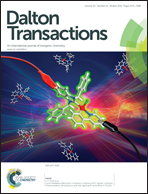Guanidine sulfate-assisted synthesis of hexagonal WO3 nanoparticles with enhanced adsorption properties†
Abstract
Large surface area hexagonal phase WO3 (h-WO3) nanowires were synthesized by a hydrothermal route with the assistance of C2H12N6O4S. They were characterized by XRD, SEM, TEM, BET, FT-IR and XPS. It is shown that C2H12N6O4S not only acts as a stabilizer to facilitate the generation of a metastable hexagonal phase, but also functions as a structure directing agent to assist the construction of nanowires. The obtained h-WO3 possesses a large specific surface area and numerous adsorption functional groups such as –OH groups. These characteristics result in an excellent adsorption performance for the removal of strontium from acidic aqueous solutions. A maximum adsorption capacity of 52.93 mg g−1 was achieved on the h-WO3 prepared in the presence of C2H12N6O4S. This value is almost two times higher than that of bare h-WO3 (no C2H12N6O4S). The effects of pH, contact time, initial Sr2+ concentration and ion strength on Sr2+ removal from the solution by h-WO3 were systematically investigated. The adsorption mechanism involving the combination of electrostatic attraction and ion exchange for the adsorption of Sr2+ is proposed. Based on our results, h-WO3 with high adsorption capacity and good surface characteristics exhibits great potential for the removal of Sr2+ from radioactive wastewater.


 Please wait while we load your content...
Please wait while we load your content...